|
Over the past few centuries, and likely before then, men harvesting
peat in European bogs have struck upon remarkable and, to the peat
cutters, no doubt frightening discoveries. More than a thousand bog
bodies and skeletons have come to light, and scientists now have the
means to study the remains in such detail that they can, in a sense,
resurrect these ancient people. Drawing on the work of Dutch
bog-body scholar Wijnand van der Sanden, the following map charts
more than 80 important finds and includes details on 12 of the most
fascinating.—Susan K. Lewis
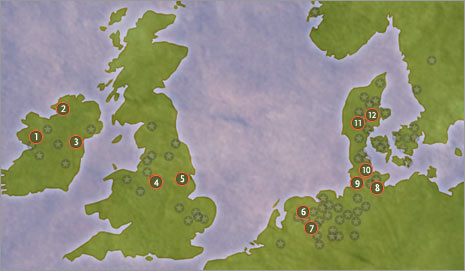


|
|
1.
|
|
Gallagh Man
400-200 B.C.
Found in County Galway, Ireland in 1821
He was discovered lying on his left side, draped in a skin
cape. Beneath the cape he was naked. Whether he once wore
linen clothes that have disappeared over time is unclear. He
was anchored to the peat with two long wooden stakes, and
around his neck was a band of willow rods likely used to
strangle him. He was roughly 25 years old at the time.
|
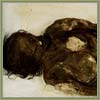

|
|
2.
|
|
Meenybraddan Woman
A.D. 1500-1600
Found in County Donegal, Ireland in 1978
The style of the woolen cloak in which she was wrapped dates
this woman to the late 16th century, distinguishing her from
the more common Iron Age bog bodies. She was in her late 20s
or early 30s when she died. Given that she was interred in a
peat bog, in what was likely an unconsecrated grave, she may
have been a murder victim or a suicide.
|
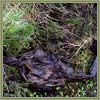

|
|
3.
|
|
Oldcroghan Man
350-175 B.C.
Found in County Offaly, Ireland in 2003
Oldcroghan Man fits the classic profile of an Iron Age bog
body. He died a gruesome death, suffering repeated cuts and
stabs before he was dismembered. Experts debate whether he was
a sacrifice to the gods, a criminal being punished, or perhaps
both. His torso, the only part of him recovered, reveals that
he was exceptionally tall for his time, standing roughly 6'
6".
|
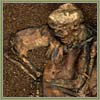

|
|
4.
|
|
Lindow Man
100 B.C.-A.D. 100
Found near Manchester, England in 1984
Examined by more than 50 experts, Lindow Man is likely one of
the most scrutinized corpses in the world. He was in his 20s
and, unlike most bog bodies, wore a beard and moustache. He
had mild arthritis but good teeth and well-manicured nails.
His death was far worse than a simple execution: he was struck
on the head, had his throat cut, and was throttled with a rope
made of animal sinew, perhaps to increase the bleeding, before
being thrown facedown into a watery bog.
|
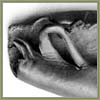

|
|
5.
|
|
Amcotts Moor Woman
A.D. 200-400
Found in Lincolnshire, England in 1747
Unearthed long before the modern era of scientific inquiry
into and preservation of bog bodies, the only remnant of
Amcotts Moor Woman is now her left shoe. The design of the
leather shoe dates her to the late Roman Period in Europe. Her
right shoe and hand were sent to the Royal Society in London
soon after she was discovered, but like many bog-body finds
before the 19th century, they have disappeared without a
trace.
|


|
|
6.
|
|
Yde Girl
100 B.C.-A.D. 50
Found in Drenthe, The Netherlands in 1897
A small percentage of bog bodies are children. Yde Girl
appears to have been strangled and stabbed at the age of 16.
Some experts believe she was selected for sacrifice in part
because of her awkward gait and curved spine (CT scans
revealed she had scoliosis). Other CT scans, of her skull,
aided the reconstruction of her face. Her long fair hair was
preserved in the peat, but on half of her head it had been cut
off. Other bog bodies also had their hair cut when they were
killed.
|
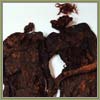

|
|
7.
|
|
Weerdinge Men
100 B.C.-A.D. 50
Found in Drenthe, The Netherlands in 1904
They were long called the "Weerdinge couple" and thought to be
a man and a woman. Experts now speculate these two men may
have been brothers, lovers, or father and son. One of them
suffered a large chest wound, and his intestines spilled out
when he was laid in his grave. According to the Roman
historian Strabo, some Iron Age Europeans tried to divine the
future by "reading" a victim's entrails.
|


|
|
8.
|
|
Rendswühren Man
100 B.C.-A.D. 100
Found near Kiel, Germany in 1871
The year Rendswühren Man was discovered, a self-taught
German scholar named Johanna Mestorf—who coined the word
Moorleiche (bog body)—published the first
catalogue of such finds. She interpreted Rendswühren Man
as a murder victim. He was 40 to 50 years old when he died,
likely from a blow to his head. Near his body were the
remnants of a woolen cloak and a skin cape. His caretakers in
the 19th century smoked his body in order to preserve it.
|
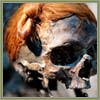

|
|
9.
|
|
Osterby Man
A.D. 1-100
Found near Osterby, Germany in 1948
Only his decapitated head was found, wrapped in a deerskin
cape. He was likely killed by a blow to his left temple before
he was decapitated. His hair, reddened by chemicals in the
peat, is tied in an elaborate hairstyle called a Swabian knot.
The Roman historian Tacitus, who lived in Osterby Man's era,
describes the hairstyle as typical of the Suebi tribe of
Germany.
|
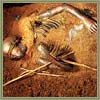

|
|
10.
|
|
Windeby Girl
A.D. 1-200
Found near Windeby, Germany in 1952
It's unclear exactly how she died, but given that she was
merely 13 to 14 years old and that she was buried in a bog
with a woolen band covering her eyes, it was likely from
unnatural causes. Only five yards from her body the corpse of
a man lay buried, and some experts suggest that the two were
punished for an adulterous affair. Like the Yde Girl, Windeby
Girl had part of her hair cut off at the time of her death.
|


|
|
11.
|
|
Tollund Man
400-300 B.C.
Found in Aarhus, Denmark in 1950
He is renowned, even beloved, for the gentle expression on his
impeccably preserved face. The noose around his neck makes
clear that, like other Iron Age bog bodies, he was killed, but
following the violent act he was carefully laid in a restful
pose, like a sleeping child. Learn more about him in
Tollund Man.
|
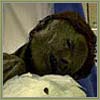

|
|
12.
|
|
Grauballe Man
100 B.C.-A.D. 100
Found in Aarhus, Denmark in 1952
Peat cutters accidentally struck his head with their shovels.
Knowing of Tollund Man and other finds in the region, they
were less shocked than they might have been otherwise.
Grauballe Man was carefully excavated under the supervision of
archeologist and bogbody specialist P. V. Glob, and has become
one of the most X-rayed and analyzed corpses in the world.
Before his throat was cut, Grauballe Man ate a soup laced with
an hallucinogenic fungus perhaps intended to induce a
trance-like state in a ritual that included his sacrifice.
|

|

|


